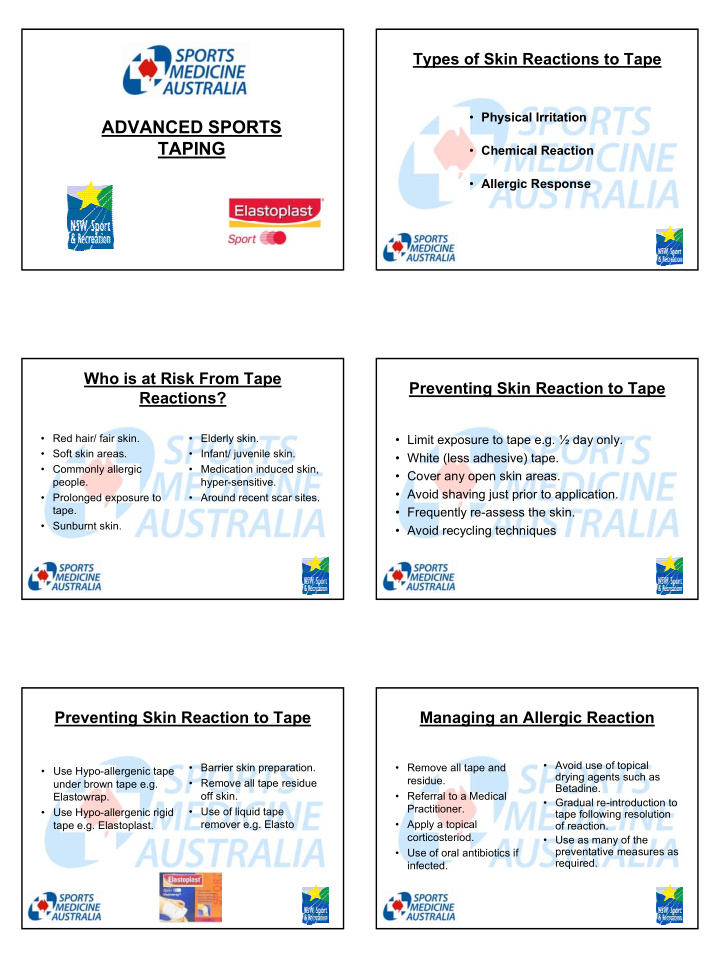



Types of Skin Reactions to Tape • Physical Irritation ADVANCED SPORTS TAPING • Chemical Reaction • Allergic Response Who is at Risk From Tape Preventing Skin Reaction to Tape Reactions? • Red hair/ fair skin. • Elderly skin. • Limit exposure to tape e.g. ½ day only. • Soft skin areas. • Infant/ juvenile skin. • White (less adhesive) tape. • Commonly allergic • Medication induced skin, • Cover any open skin areas. people. hyper-sensitive. • Avoid shaving just prior to application. • Prolonged exposure to • Around recent scar sites. tape. • Frequently re-assess the skin. • Sunburnt skin. • Avoid recycling techniques Preventing Skin Reaction to Tape Managing an Allergic Reaction • Avoid use of topical • Barrier skin preparation. • Remove all tape and • Use Hypo-allergenic tape drying agents such as residue. • Remove all tape residue under brown tape e.g. Betadine. off skin. • Referral to a Medical Elastowrap. • Gradual re-introduction to Practitioner. • Use of liquid tape • Use Hypo-allergenic rigid tape following resolution remover e.g. Elasto • Apply a topical tape e.g. Elastoplast. of reaction. corticosteriod. • Use as many of the • Use of oral antibiotics if preventative measures as required. infected.
Acromioclavicular (A/C) Joint Sprain Shoulder - Acromioclavicular (A/C) Joint Sprain Preparation: Position the shoulder at a 45 degree angle by resting the forearm on a bed or table. A. Apply Elastowrap stretch (5 or 10cm) as skin protection. Leukofoam pads are cut (Circle and Rectangle) to protect the nipple and bony prominence of the AC joint. B. Two vertical anchors of Elastoplast rigid tape are applied over the shoulder girdle. Source: http://www.pueblo.gsa.gov/cic_text/health/sports/shoulder.gif Shoulder Acromioclavicular (A/C) Shoulder Acromioclavicular (A/C) Joint Sprain (continued) Joint Sprain (continued) F. Two diagonal strips are repeated in the C. Two transverse (horizontal) anchors around the chest below nipple. opposite direction. Extra diagonal strips can also be applied alternately for added D. Two anchors are applied on the humerus at the support. level of the Deltoid insertion. G. Locking strips on the anchors reinforce and E. Tow diagonal strips in one direction are then complete the procedure by covering the applied from the shoulder anchor to the Deltoid anchor. ends of the diagonal strips. Note: Larger shoulders may need three strips Anterior Shoulder Dislocation Anterior Shoulder Dislocation Prevention Prevention (continued) A. Prepare skin. Prepare shoulder with Fixomull, nipple Orthopaedic Leukofoam C. Apply desired number of strips of sports tape Pad and vertical and transverse anchors, as starting from the deltoid anchor, anteriorly directed for A/C joint taping. and down, around the arm to the back of the upper arm, over the top and front of shoulder finishing at the vertical anchors. At 90 degree B. Position shoulder/ arm at the end of range abduction the taping should limit/ prevent of desired movement. This position will most external rotation and horizontal extension, probably be 90 degrees abduction (or just that is “putting the arm in a coat position”. short of), horizontal flexion and internal rotation. D. Lock off.
Foot Taping Elbow Epicondylar Tendonitis (Medial Longitudinal Arch) Unloading Applications: Applications: Pronation correction, plantar fasciitis, shin soreness Lateral epicondylitis=Tennis elbow, and hallux valgus (adapted). Medial epicondylitis=Golfers elbow Technique: Technique: Anchor (proximal to metatarsal heads) Unload common wrist extensor/ flex or origin or along extensor/ flex or muscle bellies. Stirrups (Along medial forefoot, around heel, cut Unload lateral to medial direction using 2-3 pieces of tape under cuboid to support the arch and finish on dorsum to forefoot). Tape: Rigid (38mm) or smaller, +/- Fixomull underneath rigid Tape: Rigid (38mm) and +/- Fixomull Knee - Anterior Cruciate Ligament Knee Anterior Cruciate Ligament (ACL) (ACL) (continued) • Apply 4 spiral tapes of 38mm Elastoplast Sports • Maintain the knee joint in 5-10 degrees of flexion. Tape from calf to mid-thigh Protect the popliteal space (back of knee) with a sponge or felt pad. • Tape 1: From the posteromedial aspect of the upper calf over the tibial tubercle to the lateral aspect of the knee, across the popliteal space and around the thigh. Knee Anterior Cruciate Ligament Scenarios to Think About… (ACL) (continued) • Tape 2: Spiral on the opposite side from the 1. IRB (Rubber Ducky) NSW SLSA posterolateral aspect of the calf to posteromedial thigh. Championships. • Tape 3: Take the same course as Tape 1 overlapping by half. IRB Operator dislocates Right Shoulder in competition, which is reduced on site and • Tape 4: Take the same course as Tape 2 overlapping iced. Devise a shoulder strapping that will by half. enable the operator to resume competition that day. • Complete the strapping with transverse locking tapes covering the thigh and calf components.
Scenarios to Think About… 2. Basketball player has minor hairline fracture over the anterior angle of his Right 9 th rib. He needs to play to stay in State qualifiers. Devise a padded rib strapping that will support the area and allow him to compete that day.
Recommend
More recommend